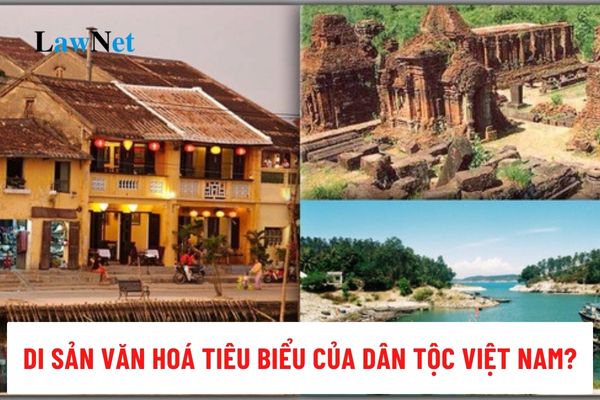Some notable cultural heritages of the Vietnamese people
Some notable cultural heritages of the Vietnamese people
Some notable cultural heritages of the Vietnamese people (suggestions) in Section 5 of the General Education Program for the History subject issued together with Circular 32/2018/TT-BGDDT are as follows:
Introducing some notable intangible cultural heritages
- Dân ca quan họ Bắc Ninh
- Ca trù
- Không gian văn hoá cồng chiêng Tây Nguyên
- Nhã nhạc cung đình Huế
- Đờn ca tài tử Nam Bộ
- ...
Introducing some notable tangible cultural heritages
- Trống đồng Đông Sơn
- Thành Cổ Loa
- Hoàng thành Thăng Long
- Văn Miếu - Quốc Tử Giám (Hà Nội)
- Quảng trường Ba Đình và Di tích lịch sử Khu lưu niệm Chủ tịch Hồ Chí Minh
- Thành Nhà Hồ
- Cố đô Huế
- Tháp Chăm
- ...
Introducing some notable natural heritages
- Các Công viên địa chất: Cao nguyên đá Đồng Văn, Non nước Cao Bằng
- Vịnh Hạ Long
- Vườn quốc gia Cúc Phương
- Vườn quốc gia Cát Tiên
- ...
Introducing some notable mixed heritages
- Khu di tích - danh thắng Tràng An (Ninh Bình)
- Khu di tích - danh thắng Yên Tử (Quảng Ninh)
In addition, the required outcomes for students when learning about the notable cultural heritages of the Vietnamese people are as follows:
- Identify the distribution locations of notable intangible cultural heritages on the map.
- Introduce the basic features of one of the notable intangible cultural heritages.
- Identify the distribution locations of notable tangible cultural heritages on the map.
- Introduce the basic features of one of the notable tangible cultural heritages.
- Identify the distribution locations of notable natural heritages on the map.
- Introduce the basic features of one of the notable natural heritages.
- Identify the distribution locations of notable mixed heritages on the map.
- Introduce the basic features of one of the notable mixed heritages.

Some notable cultural heritages of the Vietnamese people (Image from the Internet)
What are the guidelines for forming and developing students' historical capacity in Vietnam?
Based on Subsection 3, Section 6 of the General Education Program for the History subject issued together with Circular 32/2018/TT-BGDDT, the guidelines for forming and developing students' historical capacity are as follows:
The method of forming and developing historical capacity is based on the fundamental principles of historical science: through various historical sources to recreate history, restoring the formation and development of historical events and processes truthfully and objectively, simultaneously placing this development process in interaction with related factors throughout their movement.
Teaching the History subject using active teaching methods, teachers do not focus on imparting historical knowledge to students but guide them to recognize and exploit historical sources, thereby recreating the past, understanding history, making inferences, and assessments about the context, origin, and development of historical events and processes to seek historical truth scientifically, applying historical knowledge to practice, thus forming and developing historical capacity for students.
The history teaching method oriented towards capacity development emphasizes problem-solving and the use of visual aids (historical artifacts, historical pictures, maps, charts, dioramas, models, historical documentaries,...).
Teachers help students know how to search, exploit historical sources concurrently know how to analyze events, historical processes, and derive their remarks and evaluations, laying the foundation for lifelong self-study and the ability to apply historical knowledge to life understanding of Vietnam and the world's history, culture, and society.
The teaching of the History subject includes both in-classroom and extracurricular learning activities.
Teachers should expand learning spaces on the field (historical sites, cultural heritages, museums, exhibitions,...), combining in-class and real-life experiential activities.
By combining various forms of activities such as group discussions, group work, individual work,..., teachers help students become "historical role-players" to explore history, creatively applying knowledge to learning situations and real-life.
To enhance the effectiveness of historical education activities, it is necessary to combine school history education with family and social education. The coordination between three educational environments (school, family, society) is an essential foundation for forming historical capacity.
Teachers should actively establish and maintain regular contacts between the school, family, and society in historical education through coordinated models such as organizing historical tradition education activities, educating about national sovereignty for students with the participation of students' parents and social organizations.
The History subject program emphasizes the application of information technology and communications; encourages students to independently read, collect historical materials on the Internet, in libraries, and other database systems to carry out individual or group studies; develop skills in using information technology means to support the recreation, exploration, and research of history.
How to evaluate the educational outcomes of students in the History subject in Vietnam?
Based on Section 7 of the General Education Program for the History subject issued together with Circular 32/2018/TT-BGDDT, the evaluation of educational outcomes of students in the History subject is as follows:
The purpose of evaluating historical education outcomes is to determine the level of students' response to the required knowledge and historical capacity in each topic, each grade, thereby adjusting teaching activities to achieve the program's objectives.
The evaluation activity must encourage students' enthusiasm for learning, exploring, and discovering historical issues; help students gain more confidence, proactiveness, and creativity in learning.
The content of the evaluation needs to focus on the ability to creatively apply learned historical knowledge in specific situations, not centering on testing rote learning and mechanical memory recall of historical knowledge.
Through evaluation, teachers can understand students' learning status, the extent of differentiation in academic performance within the class, thereby aiding students who have not met knowledge and capacity requirements, identifying and nurturing students with a talent for history, while also adjusting and perfecting historical education methods.
Regarding the form of evaluation, it is necessary to combine continuous and periodic evaluations, teacher evaluations and self-evaluations by students; combining oral tests, written tests, practical exercises, research projects; combining objective testing and essay.

